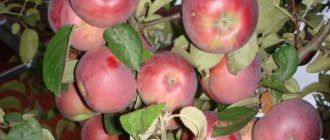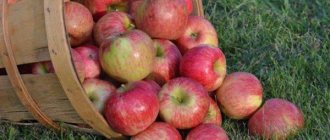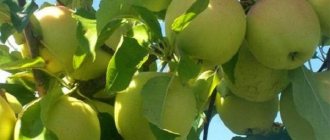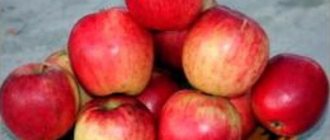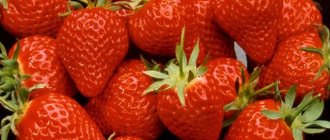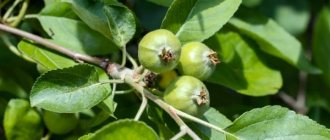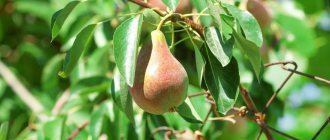The Narodnoe apple tree is an intensive variety with early autumn fruit ripening . He was bred at VNIIS named after I.V. Michurin under the guidance of Professor S.I. Isaev.
, the Papirovka and Bellefleur-Chinese varieties were crossed
The purpose of selection was to improve the characteristics of Papirovka: increasing resistance to scab and consumer value of the fruit, increasing shelf life.
From Bellefleur the Chinese, the apple received
a delicate dessert taste . S. And Isaev, the creator of the apple tree, called Narodnoye the most delicious of the 40 varieties he created. This article presents a photo and description of the variety so that you can decide on the possibility of growing it.
Important! The variety was included in the State Register in 1964 and is recommended for cultivation in the Central and Middle Volga regions of Russia.
Characteristic
Tree height
A tree of medium vigor , with a rounded, slightly spreading crown. The variety belongs to the semi-dwarf species of apple tree; The height of an adult tree does not exceed 4.5 meters . The width of the crown is commensurate with the height and reaches 4-4.5 meters in diameter.
Apple tree Popular.
Branches and trunk
They have a brown color. The shoots are straight, thick, grow sparsely, without thickening the crown.
Annual shoot growth
Equal to 35-45 cm.
Leaves
Light green in color, broadly ovoid or elongated in shape. The leaf blade is medium in size with a wavy, crenate edge.
Fruit
Regular round shape , medium size (110-140 g for an adult tree, 170-200 for a young tree). Some apples have a narrow dividing seam like the White Naliv variety.
The fruit of the Popular apple tree with a dividing seam.
The skin of an apple has numerous and small subcutaneous points . When ripe, the fruits are green-yellow. At consumer ripeness, their color changes to golden yellow.
Pulp
Yellowish-green, juicy, aromatic, with a sweet and sour dessert taste . Chemical composition of fruits:
- Dry matter - 13%;
- Ascorbic acid - 7.7 mg/100 g;
- Sugars – 11.4%;
- Tetratable acids – 0.4%.
Tasting evaluation of fruits
4.5-4.75 points.
Productivity of the variety
Tall, reaches 160 kg from an adult tree .
Winter hardiness
The winter hardiness of the variety is good, reaching – 30 °Ϲ .
The Narodnoye apple tree has good winter hardiness.
Disease resistance
Average , for scab fungus - above average.
Advice! If you need large fruits from a mature tree, remove a third of the ovaries from it. The number of fruits will decrease and the weight will increase.
Advantages and disadvantages of the variety
- Folk is rightfully considered one of the best varieties. Among its advantages:
- precociousness;
- self-fertility;
- high, stable yield;
- excellent taste characteristics;
- good transportability of apples;
- disease resistance;
- undemanding to soil composition;
- long shelf life (up to 4 months).
There are no deficiencies noted in the apple tree; the only thing that displeases gardeners is the love of wasps for this variety.
Reviews
Evgenia S, Chelyabinsk. ‟ I’m very glad that I chose this variety of apple tree, because before buying I looked at its description and photo for a long time! She pleased me with the first apples in the second year! Now she is 10 years old and I remove 10-15 buckets from her in September. The apples themselves are even, smooth and very tasty! The only downside is that wasps love it. If you leave a bitten apple on the table, they will flock to it and want to finish it))”
Victor Timofeevich, Togliatti. “The folklore has been growing with me for about 15 years now, and I have formed a personal opinion about it. It has many advantages: it quickly begins to bear fruit, yields, and a convenient tree shape. The apples, although not very large, are pleasant to taste. The drawback for me personally is that the apple itself has no blush and is not bright. The wife sells at the market, and the first to go are beautiful apples like Pepin Saffron, although Narodnoe is tastier than it. ”
Tatyana Aleksandrovna M, Voronezh. ‟ Many on the forum praise this variety, and I will join. In addition to all the stated advantages, this variety is convenient for novice gardeners. The crown of the tree grows sparsely, so it does not require frequent pruning. It will have to be pruned at 25-30 years of age, when the frequency of fruiting begins. ”
Description
Cinnamon stripe is an autumn type of apple that pollinates successfully if it grows near apiaries. Bees love the fruits of this tree, and thanks to their activity the level of productivity increases. The variety is also pollinated by trees of other varieties and does not require special conditions for growth.
Being an autumn species, the apple tree bears its fruits in September, and if the summer was hot and sunny, ripe fruits can be collected already in August.
Characteristics of the variety:
- autumn;
- short shelf life of fruits (2-3 months);
- self-pollinating;
- average apple size.
Characteristics of wood
Apple trees of this variety are pyramidal-shaped trees with a massive crown. The tree reaches a height of 5 m, and the width can be 4 m. Every year the crown becomes more powerful and dense, maintaining rapid growth.
The branches of the tree are short, drooping, the foliage is concentrated at the top of the crown. It has a characteristic deep green color and a sharp leaf shape.
The flowering period - mid-May - is distinguished by a special aroma that attracts bees and other pollinators to the pink flowers.
Description of fruits
The fruits are medium in size, flattened in shape, the color corresponds to the name - with clear drawings of vertical stripes of a brown tint. On average, one apple weighs 80 g, but there are also larger fruits.
At harvest, the color may differ slightly from that which appears at the ripening stage. The fruits can be greenish in color, they are smooth, covered with natural wax, shiny and glossy.
Advantages and disadvantages
This variety can rightfully be called the most frost-resistant. Even in harsh winters, the trees withstood the cold, waited for spring, and in the fall brought the long-awaited harvest.
The taste of the fruit brings this variety to a leading position in the apple rating. The characteristic note of cinnamon, thanks to which the apple tree got its name, will appeal to everyone. The fruits are in high demand in the market and in home cooking. They make excellent jams, and baked goods with this variety will have an exquisite taste.
The disadvantages include low productivity. Cinnamon striped can produce up to 140 kg of fruit per year. You have to wait up to 10 years after planting the tree for such a harvest.
Another disadvantage is the excessive “tenderness” of the fruits themselves: with the slightest physical impact, the quality of the apple is lost, so you should not wait until the fruits begin to fall. They are collected earlier, otherwise the gardener risks losing the marketability of the fruit.
Taste
The fruits have a good taste
The pronounced and characteristic taste only of this variety of apples will appeal to every consumer. Subtle notes of cinnamon, along with a slight taste of beeswax, create a unique tandem.
The taste of the fruit has the following characteristics:
- sweet (sugar content up to 10%);
- a slight amount of sourness (no more than 0.5%);
- cinnamon aroma.
Productivity
The apple tree produces an average harvest of approximately 150 kg per year. If there is an apiary nearby, insects with their pollination can double the number of fruits. Harvest in late summer - early autumn.
Fruit removal should be done as carefully as possible so as not to damage the apples. To store fruits for up to six months, you need to prepare a dry place for this.
Winter hardiness
The Cinnamon Striped apple tree variety tolerates frosts excellently. The tree is not afraid of temperatures even below -35 °C. If the gardener uses mulch to retain moisture, the tree can withstand any cold weather.
Landing Features
Deadlines
The best time to plant a Narodnoye apple tree is autumn, from the end of September to mid-October . This variety is frost-resistant and does not require long adaptation before winter temperatures drop.
When planting in spring ( from mid-April to mid-May ), it is important to water the plant on time so that the fragile seedling can get used to new living conditions.
For the Narodnoe apple tree, autumn planting is preferable.
Technology
Well-lit areas with fertile and breathable soils are suitable for the Narodnoe apple tree . The distance between other trees should be at least 2.5-3 meters.
5 important rules when planting any apple tree:
- Before planting, soak the roots of the seedling in water for 5-6 hours.
- Dig a hole wider and deeper than the root system of the seedling by 30-40 cm.
- Bury all “planting” fertilizers below the roots or dissolve them in water for irrigation.
- Be sure to tie the seedling to a peg, preferably using the figure-of-eight method.
- Trim apple tree branches to a third of their length.
Advice! The best way to garter a seedling is to three pegs at once! A tree that does not sway in the wind will take root faster!
Watch a video on how to plant apple trees correctly:
Care
Trees of this variety are unpretentious and do not require special care. Those gardeners who want to achieve special productivity need to water and fertilize the apple tree on time, protect the tree from pests and diseases .
Pruning and crown formation
The Narodnoye apple tree variety does not tend to thicken the crown , and in ordinary gardens does not require annual pruning. It produces a good harvest in its natural, wide-round form.
When pruning, diseased, broken and damaged branches are removed. If the tree has weak branches, in late spring or early autumn its side branches are shortened by a third, making a cut after the bud, looking in the direction “from the trunk”.
The Narodnoe apple tree requires only sanitary pruning.
Watch a detailed video tutorial on pruning and crown formation:
Watering mode
The watering schedule for a tree primarily depends on its age:
- Seedlings of the first year of planting need to be watered with 2 buckets of water once every 10-14 days (if the weather is dry);
- Adult apple trees are watered less often, but use more moisture for this, watering the entire ground under the crown;
- a tree 8-15 years old 4-5 times per season, using 10-15 buckets of water.
Important! In the fall, before the onset of frost, the apple tree needs moisture-recharging irrigation at the rate of 45-50 liters of water for each square meter of soil under the crown. If the summer and autumn were rainy, the amount of water is reduced by 1.5 times.
Feeding
An optional condition for successful cultivation. This variety is undemanding to the chemical composition of the soil :
- Spring nitrogen fertilizing is carried out when shoot growth is weak;
- Autumn phosphorus-potassium - to increase yields or when switching to the periodicity of fruiting of mature trees.
When fruiting occurs periodically, apply phosphorus-potassium fertilizers.
How and with what to fertilize apple trees correctly, watch the video below:
Description of the variety
A brief description of the variety can be contained in 2 lines: a mid-late fruiting period, tall apple tree with mediocre yield and very tasty small fruits of universal use.
Interesting! The enduring popularity of the variety is evidenced by the fact that it was previously grown in Yasnaya Polyana and is still found in the gardens of the Valaam Monastery.
Description of the tree
A young tree develops a wide pyramidal crown, the branches are long, raised upward and spaced from the trunk at an acute angle. In nurseries, the variety is easy to recognize - annual seedlings are straight, tall, with smooth dark red bark. The branches are pressed against the central shoot, pubescent only in the upper part.
Over time, the apple tree becomes broadly rounded. Skeletal branches grow close to the trunk and often break off under the weight of the fruit, damaging the central conductor. This is facilitated more by fragile wood than by a bountiful harvest. There are few overgrown shoots; they are dark brown, long, thin, drooping, making the crown appear horizontal.
The leaves are rough, rough, elongated, tapering at the base and at the tip, with strongly pronounced unequal denticles along the edge. The color is faded, from light green to gray, the pubescence of the plate is medium. Petiole with a clearly visible small stipule. Mature apple trees have weak foliage, most of the green mass is grouped at the ends of the branches.
The height of the tree is more than 6 meters. Considering the low yield and crown shape of an adult apple tree, you should think twice before planting the variety in a small area.
Flowers and fruits
In young apple trees, most flowers of medium size with light pink petals open on fruit twigs and the ends of last year's shoots. Mature trees, in addition, form a crop on the ringlets.
The apples are medium-sized and beautiful, as can be clearly seen in the photo. With intensive care, the fruits reach a weight of 90-100 g. If you leave the tree unattended or pay little attention to it, the fruits become smaller, weighing 60-70 g.
The shape of apples is called turnip-shaped; they seem to be squeezed in the direction from a shallow wide saucer to a closed funnel. There is no ribbing; sometimes the fruits are divided into inconspicuous lobes.
The peel is dry and shiny. The main color at the time of technical maturity is greenish, with the onset of consumer ripeness it turns yellow. The cover is in the form of clear dark red stripes and strokes, with a pronounced blush on the side facing the sun. The seed chambers occupy a significant volume.
The pulp of the fruit is tender, sweet and sour, with a barely noticeable bitterness and a spicy aroma of cinnamon, dense. Its color is yellowish, often uneven - a pinkish tint appears close to the skin. The taste of Cinnamon Striped apples is rated 4.8 points.
Self-fertility, pollinators
The variety is self-sterile. In the absence of pollinators, the apple tree will produce about 5% of the possible harvest. If other apple trees grow within a radius of 40 m, pollination will increase the yield. For Cinnamon Striped, the pollinator variety is not of decisive importance; the cultivar is not capricious, although it will produce more fruit in the presence of:
- Paddings,
- Grushovka Moskovskaya.
Ripening and storage periods, yield
Signal (first, single) apples appear in the 4-5th season, sometimes later. The tree begins to bear fruit when it is 10-15 years old, but even then it cannot boast of significant harvests: at a height of more than 6 m - 150 kg of apples in a good year. For comparison, the vigorous Antonovka produces 250-300 kg, and the heat-loving Snow Calvil, which is considered a productivity donor, produces 600 kg.
Important! Yield data is given for trees whose height is 6 m or more. Antonovka and Snezhniy Calvil can be grafted onto medium-sized and dwarf rootstocks, which will significantly reduce their productivity.
The variety is early autumn, bears fruit irregularly. The ripening period depends on the region. In the Moscow region, apples have been harvested since the end of August. The products are stored for up to 2-3 months; in refrigerators, the fruits wrapped in paper last for 3-5 months.
Important! The harvest must be harvested on time; apples tend to fall off on their own after reaching technical ripeness. Damaged fruit is only suitable for processing and immediate consumption, not for storage.
Winter hardiness, frost resistance, drought resistance
Cinnamon Striped is considered one of the most frost-resistant varieties (withstands -40 ° C). The winter hardiness of an apple tree is also high - this characteristic shows not the lowest temperature that the tree can withstand, but also its endurance to adverse factors during the dormant period.
The drought resistance of the variety, according to gardeners, is good. It is often planted in rarely visited summer cottages, in places where there is a lack of watering.
Advantages and disadvantages
Before planting a tree, you need to weigh its strengths and weaknesses.
| Advantages | Flaws |
|
|
Reference. The balance of sugar and acid in fruits is called the sugar-acid index. Apples are considered tasty if it is between 12.5 and 26.7. The Cinnamon Striped variety has an index close to 18.
Resistance to diseases and pests
The variety is moderately resistant to major crop diseases and is affected by insects. Every year at the beginning and end of the season, it is recommended to carry out preventive treatments, whitening the trunk and skeletal branches to a height of 120 cm. If diseases and pests occur, additional spraying is carried out with appropriate fungicides or insecticides.
Features of ripening and fruiting
Precociousness
The Narodnoe apple tree belongs to the group of especially early-fruiting varieties . It can bloom the next year after planting and produce a harvest of 3 kg of apples in the 3rd year. It is better to pick off the first flowers on the apple tree so that such an early start of fruiting does not detract from the forces needed to grow roots and shoots.
Pollination
Another advantage of Narodny over other varieties of apple trees is its self-pollinating ability. This tree bears fruit:
- In hot weather and in rain;
- When the flight of bees stops;
- In the absence of other flowering apple trees nearby.
This remarkable property allows the gardener not to worry about natural disasters during flowering.
Productivity
The yield of the variety is 140-170 kg per mature tree . Considering that the apple tree itself is small, semi-dwarf in size, its fertility is considered high. According to the observations of Doctor of Agricultural Sciences I. S. Isaeva (daughter of the creator of the variety), the yield of the semi-dwarf Narodnoye is equal to the yield of the tall Antonovka tree.
Fruit ripening and storage times
The Narodnoe apple tree is an early autumn variety , ripening from late August to early September (10 days later than Papirovka). This apple tree is one of the rare autumn varieties capable of long-term storage. Fruits with intact skin are stored until January!
Folk items can be stored until January.
Watch a video tip on how to preserve apples for the winter:
History of selection
The Narodnoye apple tree variety was artificially bred at the beginning of the second half of the twentieth century. The Belfer-Kitaika and Pakrovka varieties were used for selection.
For a gardener, the “pedigree” of the tree will be noticeable to the naked eye: the fruits of Narodny are in many ways reminiscent of Pakrovka (shape, average weight and color), and the taste can be easily identified as Belfer-Chinese - the same juiciness, the same aroma.
The variety was created by Professor Sergei Ivanovich Isaev in the city of Michurinsk.
Narodnoye was zoned in 1964 in Mordovia, Voronezh and Lipetsk regions.
In the first half of the 90s, officials stopped indicating the People's Name in the State Register due to the fact that the institute (VNIIS) did not pay for recording in the book.
Nevertheless, Narodnoye is actively grown in Russia and tolerates even Udmurt frosts remarkably well (and they reach -35C), which is why in this republic Narodnoye received the nickname “Demolished”.
Apple tree Popular on a dwarf scion
Natural semi-dwarf Narodnoe can be grafted onto a dwarf rootstock. This measure is needed to create especially compact trees that can grow in areas with high groundwater levels . For the Narodnoye variety, such rootstocks are rarely used, because this variety already has the advantages of dwarf apple tree species: early fruiting, high yield and small size.
Attention! The Narodnoe seedling on a dwarf rootstock requires special care. It needs to be watered, pruned every year and fertilized 2-3 times per season.
Growing in regions
The Narodnoye apple tree variety is recommended for cultivation in the Central region , which includes Moscow and the Moscow region. Despite the average winter hardiness of the variety (up to -30 °Ϲ), the seedlings are covered for the winter in the first year after planting.
The Narodnoe apple tree grows well in the Central region.
In the Urals and North-West Russia, the tree is more susceptible to freezing of annual growth, especially shoots that have not ripened to persistent frosts. In order for the tree to feel comfortable, for planting you need to choose areas protected from cold northern winds . It is recommended to cover young trees for the first 2-3 years after planting.
Diseases and pests
Scab
Unlike many other types of apple trees, Narodnoe is not very susceptible to scab, but cases of infection have been observed more than once.
Scab is a fungal disease that appears as a brown coating on the leaves. After plaque forms, the leaves dry out and the fruits rot.
Treatment: The first treatment is carried out in the spring with a solution of the drug Topaz. The second treatment occurs after flowering either with a solution of “Colloidal Sulfur” or with the drug “Hom”.
Powdery mildew
Also a fungal disease that affects all parts of the plant. A white, so-called “mealy” coating first appears on the tree and leaves; over time, without treatment, it turns brown.
The leaves of the affected plant dry out, growth stops, and fruits do not set.
Treatment: In the spring, treat the tree with either “Skor” or “Topaz.” After flowering, treatment with copper oxychloride is necessary, and after harvesting, with one percent Bordeaux mixture.
Useful tips
- Remove all growth growing below the grafting site! These branches are the rootstock of the apple tree, which does not have the properties of the variety you purchased;
- Do not forget to whiten the tree in late autumn - you will protect it from sunburn in the spring;
- When buying an apple tree, choose a low seedling with well-developed small (sucking) roots, a strong trunk and 2-5 branches . Tall and thin 2-3 year old seedlings are grown in the southern regions, with a large amount of nitrogen fertilizing. They do not take root well in regions with cold climates and freeze out in the first 2-4 years.
Harvest and storage
Ripe fruits have excellent taste
If long-term storage is expected, it is better to harvest an unripe crop. But it is recommended to eat the ripe fruit, which has all the richness of taste.
The collected fruits are placed in special wooden boxes, lined with sawdust in a layer of 2 cm. They are covered with paper, then the apples are placed in 5 layers, each of them is covered with paper. The fruits should not touch each other. Storage temperature should be around 0°C.
